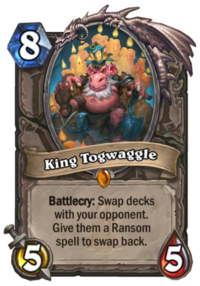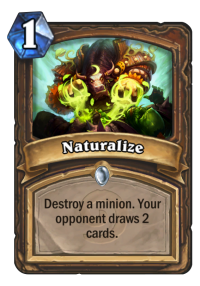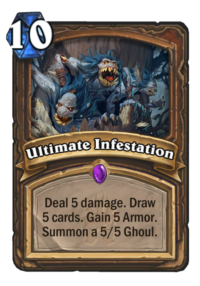Togwaggle Mill Druid General Strategy

The most important thing every mill deck has to achieve is to survive. And yes, this may sound trivial, but that very often means to take bad and ineffective trades, a lot of face damage and what players would call “hard decisions”. But what comes after the “surviving part” may be the most complex and rewarding decision-based deck to play throughout all ranks. Let’s take a look at the multiple ways to win with this deck:
The three cards we need to pull off the actual “combo” are King Togwaggle, Azalina Soulthief and Twig of the World Tree. With one durability of your weapon left you play King Togwaggle, your opponent obtains the Ransom spell and you switch decks. After that, you attack to gain 10 mana, and that enables you to play Azalina. This way you will have the Ransom spell in your hand as well, and that means that you will have the opportunity to switch decks yet again after your opponent reverted the initial switch.
This procedure works best if you have drawn your entire deck while your opponent still has a good portion of their deck left. This way you can play your two copies of Naturalize after playing Togwaggle, which results in a total of 10 fatigue damage and another 5 after you have ended your turn, making it 15 damage in total.

But that sounds horribly complicated, right? Well, it’s only one of the many ways to make this deck work!
Another realistic scenario involves a more active use of Naturalize. The key to success in this case is your opponent’s hand size: If there are six or more cards in hand, you can play one or two copies of Naturalize to max out your opponent on cards. After that you bust out King Togwaggle to switch decks, and that for free and without any catch, because your opponent milled the Ransom spell!
Those two ways to guarantee the win may sound kind of unrealistic in the first place; however, the deck has everything it needs to get to that stage of the game:
The ramp package including Wild Growth and Nourish does what it does best: It accelerates the game on your end, and we want to hit the crucial late game turns as fast as possible.
A lot of lists run Innervate for more flexibility as well and sacrifice Ferocious Howl for that; more about that in the tech cards section.
Board removal spells like Swipe, Lesser Jasper Spellstone Wrath help against early threats. Don’t be afraid to use all of those spells early and aggressively to keep the board clean; early game greed when you hold board removal in hand is the last thing you should do.
Naturalize in particular fulfills a very special role, especially in control matchups where you face early threats: You either hope to be able to remove something like a Mountain Giant later, or you accept the fact that one part of your combo will eventually not be available. That is where the aforementioned “bad trades” come in; you will regularly get into a situation where you have to sacrifice one or two cards to be able to survive. But despite all hard decisions in the early and mid game, it is more important than anything to remember that you don’t need Naturalize to win the game as a whole even against other control archetypes!
The “armor package” helps to provide a backup plan if we don’t draw into removal early. Cards like Ferocious Howl and Oaken Summons can buy you one or two turns worth of proactive healing while powering up your Spellstones at the same time.
Branching Paths serves as the jack-of-all-trades card in this list. The choose-twice mechanic can serve as a great last-minute healing tool, aggressive card draw to cycle through your deck, or a lethal threat if you have a solid board state that won’t be removed until next turn.
Spreading Plague is one of or if not the best way to deal with early board states. That is why it’s a great keep essentially against all aggro decks. As already said before, greed generally doesn’t get rewarded while playing this deck, especially against aggro lists, so don’t be afraid to buy yourself time by playing this on curve even against two or three minions.
The same goes for Malfurion the Pestilent. This card buys so much time and provides decent reach if you want to kill your opponent before fatigue hits.
Two copies of Arcane Tyrant and Ironwood Golem represent the few minions in this deck, and they don’t really require much thought in terms of tactical decisions: You hope that you don’t draw Ironwood Golem before Oaken Summons, and you play Arcane Tyrant for 0 when you can. Don’t forget to wait for your UI draws before you end the turn so that you can play a free Tyrant as well.

Ultimate Infestation serves as the keyholder for this late game combo-based deck. We ramp to play this card as fast as possible, and even overdrawing in the later stages of the game should be considered a realistic scenario if you already hold your important cards. Remember, this deck wants to cycle through itself as quickly as it can so that we give our opponent an empty deck eventually.
Last but not least it should be mentioned that this deck can win plenty of games without the mill and combo portion. The solid Druid core cards in combination with powerhouses like Ultimate Infestation and Malfurion can swing the board like nothing else, and Spreading Plague can hold off copious amounts of early aggression over multiple turns.
Togwaggle Mill Druid Matchup and Mulligan Guides
Odd Paladin/Murloc Paladin: EVEN
The matchups against Paladin’s aggro options really can go either way. Both decks can outperform the opponent by a mile based on mulligans. Try to defend yourself as much as possible; there’s no need to ramp up early because you will outvalue every aggro deck in the later stages of the game anyway.
Mulligan: Cards to keep are Wrath, Swipe, Oaken Summons, Lesser Jasper Spellstone, and Spreading Plague if you hold one of the beforementioned cards.
Token Druid/Spiteful Druid: UNFAVORED
Decks with lots of early high-value threats have always been a problem for any control-oriented Druid deck, and Token/Spiteful Druid is no expection. You simply do not have the tools do defend yourself against Spiteful Summoner or Wispering Woods into Soul of the Forest. These matches will start slower on the opponent’s side, so ramping up early is definitely an option.
Mulligan: Cards to keep are Wild Growth, Wrath, Oaken Summons, Lesser Jasper Spellstone, and Swipe if you hold one of the aforementioned cards.
Even Shaman: UNFAVORED
Similar to Token Druid, Even Shaman also includes a lot of early minion pressure combined with cheap ways to bolster the board state. However, you have a lot of ways to counter low-health minions, and an early Oaken Summons can give you enough time to get more defensive cards for the mid to late game.
Mulligan: Cards to keep are Wrath, Swipe, Oaken Summons, Lesser Jasper Spellstone, and Spreading Plague if you hold one of the aforementioned cards.
Even Warlock: EVEN
The Even Warlock matchup is a swingy one due to the nature of the opponent’s archetype. As it has been for the longest time, these Warlock type of decks can curve out like no other tempo-based list, and while we have a lot of suitable board removal against its threats, we can run into some problems especially in the late game and Gul’dan.
Mulligan: Cards to keep are Wrath, one copy of Naturalize, Oaken Summons, and Lesser Jasper Spellstone.
Spell Hunter: HIGHLY UNFAVORED
On paper this may be the worst matchup for Togwaggle Mill Druid. The ability to summon mid-sized minions over and over again due to cards like Lesser Emerald Spellstone or Flanking Strike is simply too much for the type of removal a Druid has to offer, and Deathstalker Rexxar only adds insult to injury.
Mulligan: Cards to keep are Wrath, one copy of Naturalize, Oaken Summons, and Lesser Jasper Spellstone.
Tempo Mage: SLIGHTLY FAVORED
This matchup plays very similar to other aggro lists; a big plus however is that Druid can deal very effectively with Mage secrets. Cards like Counterspell or Explosive Runes have way less effect compared to other control lists. It is still imperative to play smart and take bad trades early; that way you can armor up in the mid game and go for the long haul.
Mulligan: Cards to keep are Wrath, Swipe, Oaken Summons and Lesser Jasper Spellstone.
Control Priest/Quest Priest: HIGHLY FAVORED
The matchup against Priest is where a deck like Togwaggle Mill Druid really shines. Most Priests rely on damage through Mind Blast, and Armor basically counters the whole concept of Control Priest. The same goes for Quest Priest, because it really doesn’t matter if your opponent can heal up to 40 for one time during the game.
Mulligan: Cards to keep are Wild Growth, Nourish, and Oaken Summons.
Odd Rogue: FAVORED
Odd Rogue can dish out huge amounts of damage in the early stages of the game. However, copious amounts of armor can help to outlast the onslaught, and combined with well-fitting removal against high-priority threats like Hench-Clan Thug and Edwin VanCleef you can get out of the mid game alive and well.
Mulligan: Cards to keep are Wrath, Swipe, Oaken Summons, Lesser Jasper Spellstone, and Spreading Plague if you hold one of the aforementioned cards.
Taunt Druid: FAVORED
Taunt Druid is obnoxious, but that is basically it. You can easily out-armor the incoming damage, and the ability to mill key cards like Hadronox can win you the game in a heartbeat. Don’t forget to not use Spreading Plague too early.
Mulligan: Cards to keep are Wild Growth, Nourish, and Oaken Summons.
Quest Warrior/Control Warrior: FAVORED
Again, other control archetypes do have problems with this list. Quest Warrior may perform a bit better if they curve out really well on taunt minions, but Dead Man’s Warrior will be nothing more like a dead man if you steal their most favorite toys in the later stages of the game.
Mulligan: Cards to keep are Wild Growth, Nourish, and Oaken Summons.
Togwaggle Mill Druid Tech Cards and Replacements
In general, it is very hard to tech this archetype in particular. The combination of a set amount of cards to pull of “the combo” and the needed Druid core cards to survive until that point makes it hard to replace any cards.
Innervate/Ferocious Howl: As already mentioned, lots of lists run either of these two options, and that is totally your choice to make. Innervate offers more aggressive plays against control, while Ferocious Howl makes you more robust against aggro and tempo-based decks.
Lorewalker Cho: This card is very interesting if you really want to get in on that Ransom shenanigans. It’s more of a meme card than anything, but it will win you any mirror matchup!


















Technically it’s Malygos Druid with different finisher. 🙂 Tons of healing, cycling and if twig is neutralized: 2x naturalize + Togwaggle is gg for your oponnent. Why Tier 3?
Togwaggle Druid will most likely be a better deck than it was in the last meta!
Does a meme deck rly work?
Last season I went 20-12 with it, just before writing this guide. Lots of noteable streamers climbed with this deck as well. It’s hard to pilot but very rewarding, and it performs well if you believe in it and your opponent doesn’t know what he’s up against!
2x Starfall are really nice to clear problematic boards…
As a Wild only player it’s really cool to see decks like this and Malygos Druid see success without the power of Aviana / Kun.
Extra “e” in higher under the introduction part. 🙂
StreetPiglet, the watchful reader every writer needs to have in his comment section! Thanks, corrected 🙂
No problem, thanks for the decklist, I had trouble with this deck up until this list came out. Currently with the shown here I am 9-2 only losses against odd rogue. 😉